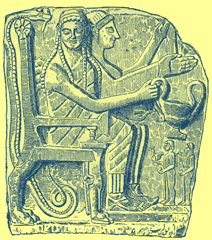
From Greek and Roman Mythology & Heroic Legend, by Professor H. Steuding, Translated from the German and Edited by Lionel D. Barnett. The Temple Primers, London: J. M. Dent; 1901; pp. 3-5.
[3]Greek and Roman Mythology & Heroic Legend
GREEK MYTHOLOGY
Beginnings of Greek Belief and Worship
II. Nether-World Powers: Heroes. § 4. Even in this age there was a universal worship in Greece of powerful beings dwelling under the earth in cavern-like chambers, who were styled either Underground Gods (χθόνιοι) or Heroes. Of the latter tales were sometimes told (as that of Amphiaraos, in the region of Thebes and Oropos, § 172), that they had been translated without dying to their dwelling-place under the earth; they nevertheless received offerings of the sort usually presented to the dead. They all exerted their influence only in the neighbourhood of their abode, generally by appearing in significant dreams to those who slept over it (incubatio), and revealing either future events or the proper remedies for sickness. They are clearly the lords of the souls dwelling in the soil of their country; their halls may have been originally imagined as like the underground temples connected with the graves of kings which have been unearthed at Mykenai and elsewhere.
§ 5. It seems to have been generally the reputed ancestors (άρχηγέται) of families who were regarded as heroes, for thereby the belief in their former existence on earth was kept alive among their worshippers.1 These were distinguished from the common dead only by the fact that they received 4 adoration from a whole family, or an association of that nature. Their grave, used as a place of sacrifice, formed always the central point of their worship. In the later representations of art, which are certainly based upon ancient conceptions, they usually appear as warriors, because tribal ancestors were generally described as such, and often on horse, seated on a throne, or reclining on a dinner-couch and feasting,2 surrounded by their worshippers, who, as mortals, are drawn in much smaller proportions than the heroes themselves. Hence their usual attribute has come to be the cup, as well as armour, the horse, and the snake.

Spartan Relief. Berlin.
These primitive heroes however are even in Homer so intimately associated with forms created by the poets themselves, their own history and deeds have been so thoroughly 5 transfigured and recast by poetry, that the original element can no longer be threshed out. Hence Heroic Legend, great as is its antiquity in part, must take the last place in the order of our exposition.
FOOTNOTES
1 See however E. Meyer’s appendix to his Ursprung der Odyssee in Hermes xxx.
2 On the so-called ‘funeral-banquet reliefs’ (on which see Mittheil. d. deutschen archaeol. Inst. zu Athen. xxi. 347 ff.).
Next :
Greek Religion from the Beginning of the Homeric Age :
III: Nature and Elemental Powers.